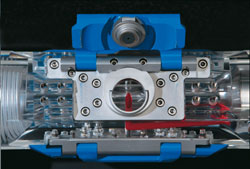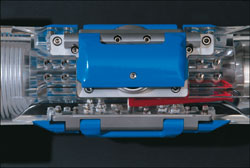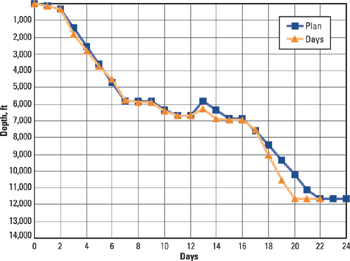New slimhole rotary steerable system at work in Sultanate of Oman
DrillingNew slimhole rotary steerable system at work in Sultanate of OmanIn its first land use, the new system saved time, minimized risk and achieved its targetsH. Owens, Occidental of Oman; D. Carrington, Schlumberger, Oman; and Dr. G. Downton, Schlumberger, UK A new drilling technology ensures as smooth a wellpath as possible, while at the same time increasing rate of penetration (ROP). It enables greater control of directional drilling using constant rotation to intersect more targets in a longer hole section, and it minimizes the risk of stuck pipe. The new technique – slimhole rotary steerable system – was first used in completing three onshore wells this past spring and summer: Safah Wells 198, 204 and 203. This article describes Occidental Oman’s experience using the new system in drilling these wells. Background Oman’s Safah field is an important asset for Oxy’s Middle East operations. Since its discovery in 1983, cumulative gross production from the Block 9 area has exceeded 160 MMbbl, with most coming from Safah. In typical Occidental wells, penetrating the planned targets using standard systems requires drilling in the sliding mode 30% of the time. During these periods, ROP drops by two-thirds. This is because, with conventional drilling, there is a strong likelihood that targets will be missed in the rugged wellpaths the sliding process leaves in its wake, as well as hole cleaning difficulties, whereby cuttings build up around the practically immobile drillstring, from which stuck pipe can arise. The new slimhole rotary steerable system allows faster and better execution of steering decisions during drilling. A single slimhole well trajectory can intersect multiple targets and be adjusted more accurately for optimum reservoir drainage. This capability is of particular importance in Oman, with its heavy reliance on energy revenues to sustain its government and economy. Operating Principle/Design Externally, the slimhole system looks deceptively similar to the larger sizes. However, the smaller size tools experience much higher shocks and more unpredictable loading conditions because of their more flexible structure. Thus, it was necessary to subject the design’s structure to extensive shock testing to ensure adequate design margins. The pads used to bias the tool were designed to be proportionately larger to improve their wear life and reduce contact stresses with the formation. All electronics and circuit boards, including sensors and communications circuits, were designed to rigorous standards of ruggedness. There has been no mechanical failure to date of any part of the system in more than 30,000 ft drilled, and all tools have reached TD with plenty of wear life remaining. The system provides rotary steering for all directional-drilling applications – from tangent sections to extended-reach drilling. The technology is a true rotary system with no stationary components touching the borehole. The tool is based on larger-sized systems that provide the same functionality. There was considerable experience available concerning the issues and challenges for upscaling the technology – that is, taking the first design from 8-1/2-in. hole size through 12-1/4-in., 14-3/4-in., 17-1/2-in. to 18-1/4-in. (including several intermediate sizes). However, the reverse step of miniaturization raised many issues regarding structural integrity, robustness and erosion damage. When designing the slimhole-sized system, Schlumberger engineers wanted to make full use of successful concepts used in its line of rotary steerable tools and supporting technology, which have six years of commercial success. However, the engineers could only go so far. As things got smaller, new design concepts were needed. Fortunately, tool strength was well preserved in its smaller size. This is because the load path along which the torsional load must travel is on the outside of the collar. The new technology comprises a control unit – which controls a rotary-valve (in the bias unit) that can be held stationary when it is necessary to steer the tool – and the bias unit itself. There are three pad openings in the bias unit which are located as close to the bit as possible to enhance dogleg response. As the bias unit rotates, mud is switched to each pad in turn by the rotary valve, causing the bit to be deviated in the required direction by a synchronous biasing mechanism, Fig. 1.
The driller, who communicates with the tool via mud-flowrate changes, can indicate to the control unit the direction and percentage of steering. A new, optimized rotary-valve design provides a phase angle that leads to dynamic steering-bore optimization. As with other PowerDrive Xtra* systems, the design uses materials and face contours that reduce valve friction. In addition, it employs a new spring-loaded mechanism that significantly improves steering performance under shock and vibration. Field Experience One rotary steerable system was used in both Safah 198 and 204, while another was used in Safah 203. Safah Well 198. This well, a 6 1/8-in. slimhole lateral drilled for Occidental Petroleum – Oman, was geosteered 4,712-ft using thePowerDrive* 475, the world’s first 4 3/4-in. rotary steerable system. This well – located in the east area of Safah field – was designed as a single lateral waterflood injector targeting the upper Shuaiba reservoir as part of an ongoing waterflood development plan. To respond to significant gas influx from a nearby injector well, mud weight had to be increased and drilling rates needed to be controlled at times. Use of conventional mud motors on Safah 198 would have been slow, and it may not have been possible to reach TD. Safah Well 204. With this Safah well, 4,693 ft were drilled with the new system. The well target was in an area similar to the Well 198 target. The lateral section was planned to be drilled in six days. Instead, it was drilled in four days, enabling the well to make up for some time lost on an 8 1/2-in. hole section, bringing the well in on schedule, Fig. 2. The well was completed as a producer.
Safah Well 203. Unlike the first two wells, the lateral section of Well 203 was drilled in two runs. The first run used a conventional steerable motor BHA due to a late change in the landing point depth. The revised plan required a build rate of 15.75°/100 ft, rather than the planned 5.1°/100 ft. The new system is conservatively rated to 8°/100 ft, with a much higher theoretical limit, and it was thought imprudent to test the system beyond its rated limitations at this early stage. Communication Throughout the field runs in Oman, communication with the design team was critical. On the first well drilled, representatives from the Stonehouse Product Center in the UK, where the tool was designed and built, were present at the rig site to help prepare the tool for the run and to address any unforeseen problems that might have occurred. However, during subsequent drilling, a direct line of communications was established from the remote site in Oman to the design team, so that issues could be handled without personnel having to physically be onsite. When taken back to the Product Center for analysis and examination, both sets of slimhole rotary steerable assemblies were in remarkably good condition. No significant design modifications have been found necessary.
|
||||||||||||||||||||||
- Coiled tubing drilling’s role in the energy transition (March 2024)
- Oil and gas in the Capitals (February 2024)
- Using data to create new completion efficiencies (February 2024)
- Digital tool kit enhances real-time decision-making to improve drilling efficiency and performance (February 2024)
- E&P outside the U.S. maintains a disciplined pace (February 2024)
- U.S. operators reduce activity as crude prices plunge (February 2024)
- Applying ultra-deep LWD resistivity technology successfully in a SAGD operation (May 2019)
- Adoption of wireless intelligent completions advances (May 2019)
- Majors double down as takeaway crunch eases (April 2019)
- What’s new in well logging and formation evaluation (April 2019)
- Qualification of a 20,000-psi subsea BOP: A collaborative approach (February 2019)
- ConocoPhillips’ Greg Leveille sees rapid trajectory of technical advancement continuing (February 2019)







